請雙擊下方英文字幕播放視頻。
譯者: Shang-Yung Sun
審譯者: Max Chern
00:07
If you ever find yourself
gazing at falling snow,
0
7761
3318
如果你曾經凝視過飄落的雪
00:11
why not catch a few snowflakes
on your glove and examine their shapes?
1
11079
4263
何不試試用手套接幾片雪花,
仔細觀察它們的形狀?
00:15
You might notice
that they look symmetrical,
2
15342
2096
你可能會注意到
它們看起來很對稱
00:17
and if you look closely,
3
17438
1345
但如果你更靠近一點看
00:18
you'll see they have six sides.
4
18783
2341
你會發現它們都有六個邊
00:21
You could say a snowflake
is simply frozen water,
5
21124
3093
你可以說雪花就是結凍的水
00:24
but compare one
with an ice cube from the freezer,
6
24217
2656
但把它和冷凍庫裡面的冰塊比較一下
00:26
and you'll realize
they're very different things.
7
26873
2929
你就會了解其實它們差異很大
00:29
Unlike ice cubes, formed when liquid
freezes into a solid,
8
29802
4205
它不像冰塊,
冰塊是由液體結凍成固體
00:34
snowflakes form when water vapor
turns straight into ice.
9
34007
4684
而雪花是由水蒸氣直接結凍成冰
00:38
But that still doesn't explain why
snowflakes have six sides.
10
38691
3729
但這仍然沒有解釋
為什麼雪花會是六邊形
00:42
To understand that,
11
42420
1708
為了瞭解原因
00:44
we need to delve deeper
into the physics of water.
12
44128
3628
我們需要更深入探索水的物理特性
00:47
Water is made out of two hydrogen atoms
and one oxygen atom.
13
47756
4593
水分子是由兩個氫原子
與一個氧原子所構成
00:52
A single water molecule
thus has ten protons and ten electrons,
14
52349
5163
因此,一個水分子中
會有十個質子和十個電子
00:57
eight from oxygen
and one from each hydrogen atom.
15
57512
3436
八個來自於氧,
而兩個氫原子各提供一個
01:00
The two electrons
from oxygen's outer shell
16
60948
2402
氧原子最外殼層的兩個電子
01:03
are shared with two electrons
from both hydrogens as they bond together,
17
63350
5199
和兩個氫原子的電子互相分享
鍵結在一起
01:08
and the remaining
four outer shell electrons from oxygen
18
68549
3179
氧原子剩下的四個外層電子
01:11
form two pairs.
19
71728
2116
則形成兩個電子對
01:13
We call the bonds between these atoms
covalent bonds.
20
73844
4019
這些原子之間的鍵結,
稱為「共價鍵」
01:17
The pairs of electrons
are all negatively charged.
21
77863
2949
電子對全都是帶負電
01:20
Similar charges repel,
22
80812
1832
同性相斥
01:22
so they tend to stay as far away
from each other as possible.
23
82644
4075
所以它們盡可能的遠離彼此
01:26
The pairs form four electron clouds,
24
86719
2639
這些 電子對 會形成四個「電子雲」
01:29
two of which are where the hydrogen
and oxygen share electrons.
25
89358
4561
其中兩個是由氫和氧共價產生
01:33
The repulsion between the unbonded pairs
26
93919
2309
沒有共價的電子對
01:36
is even stronger than repulsion
between the shared pairs,
27
96228
3589
斥力比共價的電子對還要強
01:39
so the two hydrogens
get pushed a little further
28
99817
3369
所以兩個氫原子被推遠離些
01:43
to an angle of 104.5 degrees.
29
103186
4018
形成一個 104.5 度角
01:47
The water molecule as a whole
is electrically neutral,
30
107204
3243
水分子整體而言是電中性
01:50
but oxygen gets
a larger share of electrons,
31
110447
2819
但共價的電子會比較傾向靠近氧
01:53
making it slightly negative
and the hydrogens slightly positive.
32
113266
4594
致使氧微帶負電荷,
而氫微帶正電荷
01:57
Due to its negative charge,
33
117860
1442
因為氧微帶負電荷
01:59
the oxygen in one molecule
34
119302
1990
所以水分子中的氧
02:01
is attracted to the positive charge
of the hydrogen in another molecule.
35
121292
5135
會被另一個水分子中
帶正電荷的氫所吸引
02:06
And so a weak bond
between the two molecules,
36
126427
2530
因此,兩個分子之間
形成一個較弱的鍵
02:08
called a hydrogen bond,
is formed.
37
128957
2594
稱為「氫鍵」
02:11
When water freezes, this bonding
occurs on repeat,
38
131551
4078
當水結冰時,這種結合持續產生
02:15
ultimately forming a hexagonal structure
39
135629
2349
最後形成六角形結構
02:17
due to the angle between hydrogens
and oxygen within each molecule.
40
137978
4887
那是因每個分子中
氫、氧之間的角度所致
02:22
This is the seed of a snowflake,
41
142865
2628
這即是雪花的晶粒
02:25
and it retains a hexagonal shape
as it grows.
42
145493
3216
當它增大時,
仍繼續維持六角形的形狀
02:28
As the snowflake moves through the air,
43
148709
2092
當雪花在空氣中飛舞時
02:30
water vapor molecules
stick to the six sharp edges
44
150801
4325
水蒸氣會附著在其六個銳利邊緣
02:35
and expand the snowflake outwards,
bit by bit.
45
155126
4108
雪花因此漸漸往外擴大
02:39
A snowflake's developing shape depends
on atmospheric conditions,
46
159234
3860
雪花的形狀則依大氣的狀態而定
02:43
like humidity and temperature.
47
163094
2638
例如濕度及溫度
02:45
As a snowflake falls,
48
165732
1373
當雪花落下時
02:47
changes in weather conditions
can affect how it grows,
49
167105
3460
天氣的條件也會影響其形成
02:50
and even small differences in the paths
two snowflakes take
50
170565
3898
甚至兩片雪花飄落路徑中,
條件有些不同
02:54
will differentiate their shapes.
51
174463
2395
形狀就會不一樣
02:56
However, since conditions at the six
sharp edges of one snowflake are similar,
52
176858
4848
既然每片雪花的六個銳邊
其條件都相似
03:01
a symmetric snowflake can grow.
53
181706
2731
雪花便形成對稱形狀
03:04
Weather conditions
affect snow on the ground, as well.
54
184437
3115
天氣條件也會影響地上的雪
03:07
Warmer ground temperatures produce
a wetter snow that is easier to pack
55
187552
4495
較高的地面溫度
會產生較濕且易黏聚的雪
03:12
because liquid water molecules
help snowflakes stick to each other.
56
192047
4749
因為液態水分子
促使雪花互相黏合一起
03:16
Melted snow also plays a critical role
in another wintry activity, skiing.
57
196796
5852
融雪也是冬季運動的重要角色 ── 滑雪
03:22
Completely dry snow
is very difficult to ski on
58
202648
3558
完全乾的雪是很難滑行的
03:26
because there's too much friction between
the jagged snowflakes and the ski surface.
59
206206
5132
因為凹凸不平的雪花和滑雪板之間,
有極大的摩擦力
03:31
So what's happening is that as skis move,
60
211338
2636
當滑雪板移動時
03:33
they rub the surface of the snow
and warm it up,
61
213974
3530
它們摩擦雪地的表面,使它增溫
03:37
creating a thin layer of water,
which helps them slide along.
62
217504
4017
產生一層薄薄的水,幫助滑雪板滑動
03:41
So technically,
it's not really snow skiing,
63
221521
3013
所以嚴格說,我們並非真正在滑雪
03:44
but water skiing.
64
224534
2250
而是在滑水
03:46
But it is true that
no matter how hard you look,
65
226784
2632
但是的確,不管你多認真找
03:49
you're almost definitely not going to find
two identical snowflakes,
66
229416
4649
你幾乎絕對不可能找到
兩片一模一樣的雪花
03:54
and that's a mystery that scientists
are still trying to solve,
67
234065
3696
這也是個科學家們正極力解答的謎團
03:57
though we know that it has to do
68
237761
1576
我們知道的是
03:59
with the many possible
branching points in snowflake formation,
69
239337
3914
它與雪花形成中眾多的分支點
04:03
and the differences
in temperature and humidity,
70
243251
2944
及不同溫度、溼度有所關聯
04:06
and while we wait for the answer,
71
246195
1859
而當我們仍在等待答案時
04:08
we can enjoy watching these tiny fractals
falling from the sky.
72
248054
5066
請好好觀賞這些從天而降的小碎片們吧
翻譯:Shang-Yung Sun
New videos
關於本網站
本網站將向您介紹對學習英語有用的 YouTube 視頻。 您將看到來自世界各地的一流教師教授的英語課程。 雙擊每個視頻頁面上顯示的英文字幕,從那裡播放視頻。 字幕與視頻播放同步滾動。 如果您有任何意見或要求,請使用此聯繫表與我們聯繫。







